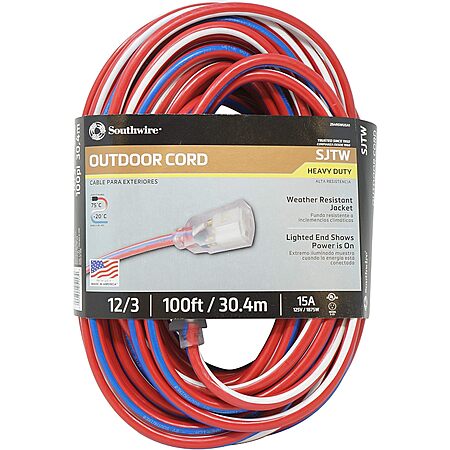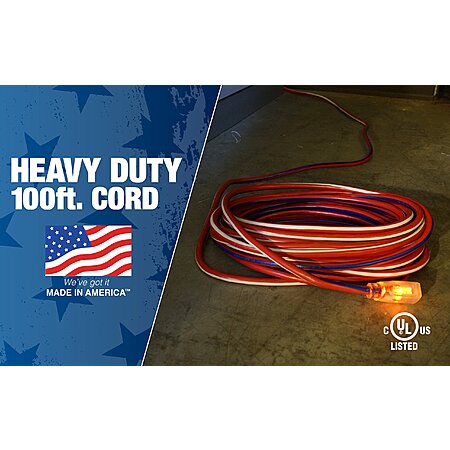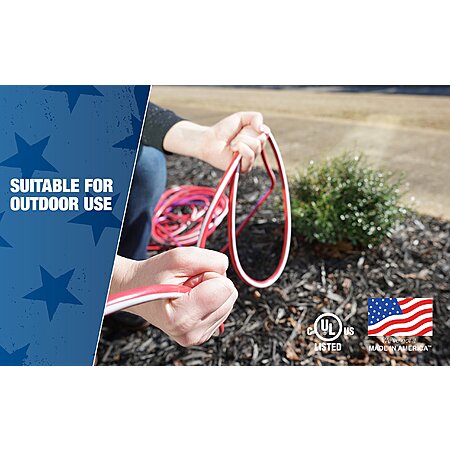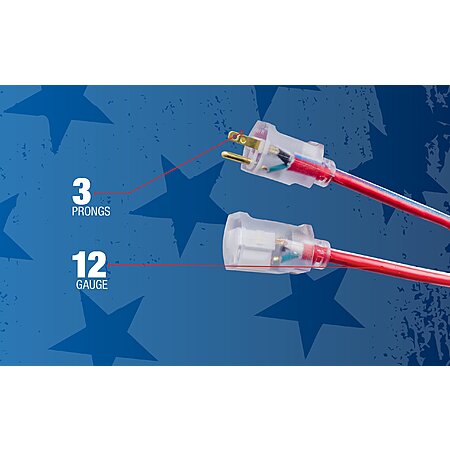expiredgaamn114 | Staff posted Mar 19, 2025 08:51 AM
Item 1 of 5
Item 1 of 5
expiredgaamn114 | Staff posted Mar 19, 2025 08:51 AM
100' Southwire 12/3 SJTW Heavy Duty Extension Cord w/ Lighted End
+ Free Shipping$53
$86
38% offAmazon
Visit AmazonGood Deal
Bad Deal
Save
Share





Leave a Comment
Top Comments
People have left my "repaired" cords alone. Even found one sitting in a parking lot after it fell off my truck.
The longer the cord, the lower the peak.
64 Comments
Sign up for a Slickdeals account to remove this ad.
Normally, 14 awg wire is capable of 15 amps and 12 awg is capable of 20 amps.
It looks like the reason is continuous use vs peak:
12 AWG copper wire is suitable for a 20-amp circuit, and it's a common practice in residential wiring. However, for continuous loads exceeding 3 hours, it's recommended to limit the load to 80% of the breaker rating (16 amps). - Google AI
The Partybox Ultimate is a MUCH larger speaker and rated at 1100 watts. It's definitely going to draw more power than the 710.
Normally, 14 awg wire is capable of 15 amps and 12 awg is capable of 20 amps.
It looks like the reason is continuous use vs peak:
12 AWG copper wire is suitable for a 20-amp circuit, and it's a common practice in residential wiring. However, for continuous loads exceeding 3 hours, it's recommended to limit the load to 80% of the breaker rating (16 amps). - Google AI
Google AI is negligent in omitting the most important aspects of the wiring/amperage info.... stranded vs solid and the distance of the run.
Google AI also omits that the main reason for their stated 80% figure is because of max amp load on the breaker, far more so than the wire.
Google and Google AI (yet another 'tool' in the agenda of dumbing down the population). It gets ppl to just blindly believe whatever it pumps out instead of having ppl receive the 'big picture' (full & accurate info).
For the permanently misguided Google lovers, I'm sure you'll be downvoting, which also proves the agenda a success and true. 😁
As for the other poster who says he prefers buying multiple shorter length cords (say,, four 25' cords) versus buying a 100' cord and apparently doesn't see the drawbacks in using multiples, each shorter cords plug-in connection is the drawback. It inserts a point of potential mid-high resistance in the current which is not there in the continuous cord. The most common example of this resistance is when the plug burns & melts on higher amperage devices like portable space heaters, and that's just from the wall receptacle to plug connection. The 'friction' connection between any plug's blades and any receptacle's blades can sometimes/often be a point of significant increase in current resistance, which doesn't exist in a continuous conductor/wire and it's a weak link that need not exist.
I also get these all rubber SJOOW cords but they are more than double the price: https://www.menards.com/main/elec...c-6410.htm. I've got 1x100', 1x50' and 1x25'. I use these in cord reels as they are more manageable than the SJTW's
for a few dollars more consider the PF TOP RATED: https://www.amazon.com/US-Wire-Ca...ast_sto_dp
Here's a great article, in plain English, on how to choose an extension cord. In short:
Settle for the 14 Gauge Or 12 choice of extension cordGauge - What you Must Know
Now that you have a general idea of what to expect or look out for when choosing extension cords, you need to decide which of the most popular gauges would work in different situations. The 14 and 12 gauge extension cords are among the most popular used types of cords. While there are different gauges, including the 16 and 10 gages, 12 and 14 are the most common. However, they carry different power amounts depending on the length of the cord in question. For instance, for a length of 25 - 50 feet, a 14 gauge cord will be great for 14-15 Amps, whereas the 12 gauge will work for 16-20 Amps.
For 100 feet, the 14 gauge cord works for 11-13 Amps, while the 12 gauge cord is best suited for 14-15 amps. If your cord is 150 feet long, the 14 gauge is best suited for 1-7 Amps, whereas the 12 gauge will support 8-10 Amps. This shows that the extension cord's length also plays a part in the power it helps safely.
Whenever you purchase an extension cord, make sure to understand the load it carries depending on the length of the cord. This will help you avoid overloading the extension cord and causing any harm to your appliances or yourself. The last thing anyone needs is to generate an electrical fault that can be more dangerous than good.
https://www.americord.c
Sign up for a Slickdeals account to remove this ad.
Also, is it "Made in America"?
Notice the packaging and cord say:
"We've got it
MADE IN AMERICA tm"
This is a trademark slogan... I'm willing to bet it's NOT made in America.
Deceptive how the "made in america" is bold also....
Also, the proper labeling is "Made in USA", so this is not that... so likely made in elsewhere (China?)
According to the Federal Trade Commission, "Made in USA" means that "all or virtually all" the product has been made in America. That is, all significant parts, processing and labor that go into the product must be of U.S. origin
I'm sure it's a fine 12/3 cord, just don't expect too much.
My $.02
https://www.southwire.c
Features & Benefits
EXTRA DURABLE
MADE IN AMERICA: Display AMERICA'S COLORS on the jobsite with this patriotic striped contractor grade extension cord
ALL PURPOSE EXTENSION CORD rated for -40F to 140F (-40C to 60C) Indoor and Outdoor use, suitable for jobsites, workshops, warehouses, and more
WATER RESISTANT: Flexible vinyl jacket provides protection of the cord against moisture, abrasion, and sunlight
HEAVY DUTY 25 foot all-copper wire extension cord recommended for use with heavy duty equipment and tools
EXTRA DURABLE oversized, clear molded plug prevent accidental bending or breaking and UL listed for your safety
15 Amps, 125 Volts, 1875 Watts
My understanding, for example, was that a 25' cord was rated to be used by itself only... and that same 25' section is not designed or intended to be part of a longer length and could potentially be bad as it wasn't made to be carrying a current at that length.
But like I said, someone with more knowledge should probably say for sure...?
But I would not recommend this calculation as mistakes could be made. One good rule is that if the cord is even slightly warm to the touch you are overloading it.
Sign up for a Slickdeals account to remove this ad.
Leave a Comment